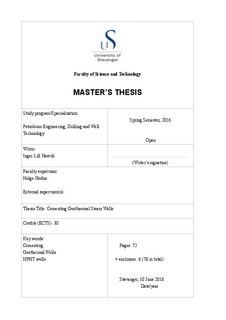| dc.description.abstract | Cementing wells with severe temperatures and/or pressures has become a common matter over the years. Running casing and designing the cement job is very difficult with temperatures above 150°C (300°F) which is a common temperature range in geothermal steam- and HPHT wells. The downhole temperature controls the pace of cement hydration and one major concern in geothermal- and HPHT wells is maintaining strength stability in cementing compositions at 370°C (700°F).
Cementing thermal wells requires solutions for obstacles, such as increased thickening time, strength retrogression, thermal shock, lost circulation and corrosion. These obstacles requires for a complex job design, not only in, a chemical properties design view, but also in placement technique and pumping pace of the slurry. Comprehensive research to enhance the integrity of the cement in thermal environments has been done, and previous work failures has contributed to several finding that has improved the cementing solutions for geothermal well conditions, especially the ones containing corrosive formation fluids.
Three cases have been studied, together with a literature review to provide an overview of the cement job designs chosen, integrity of the cement slurry, and reasons for failure. Furthermore, the cementing solutions were studied to look at what additives improved integrity and stability. What kind of laboratory tests were performed to support the design solutions.
The study has shown that certain cement additives are here to stay, such as silica flour, pozzolans, and elastic-behaving chemicals. A key issue in successful cement sheath integrity has proven to be directly related to proper hole preparations and drilling fluid removal. Knowing as much as possible about the wellbore parameters is necessary to provide proper computer software simulation testing of the cement slurry. Laboratory tests and simulations should be as real as possible, and as many as possible of these tests should be performed to to ensure the cement slurry can withstand the actual well conditions.
| nb_NO |
